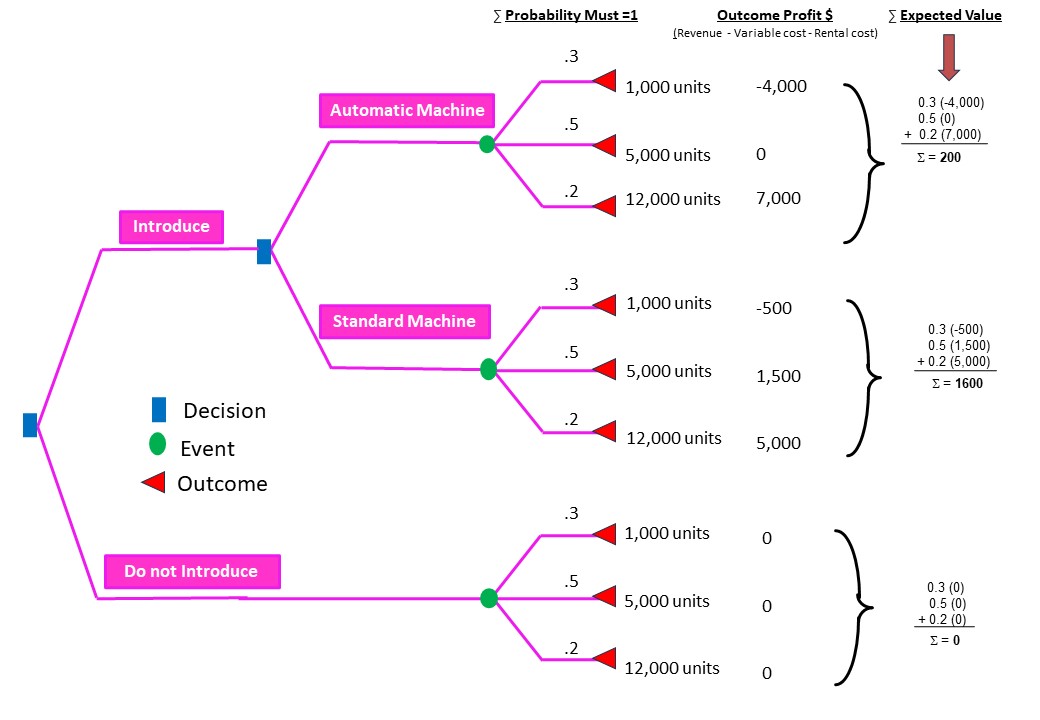Determining the Most Favorable Outcomes
A decision tree is a flowchart tree structure with decision nodes, event nodes and outcome nodes. Each internal node denotes a test on a characteristic, each branch represents an outcome of the simulation test, and each leaf node holds a class label. It is a flexible and versatile supervised machine-learning algorithm, which can be used for both classification and regression problems. During training, the decision tree algorithm selects the best characteristic to split the data based on a metric such as entropy or Gini impurity, which measures the level of impurity or randomness in the subsets. The goal is to find the characteristics that maximizes the information gain or the reduction in impurity after the split.  Decision trees are used in many fields, including finance, healthcare, and engineering. They are particularly useful when the data is complex and difficult to understand, and when there are many variables that need to be considered. Decision trees can help to identify patterns and relationships in the data, and can be used to make predictions about future events.
Decision trees are used in many fields, including finance, healthcare, and engineering. They are particularly useful when the data is complex and difficult to understand, and when there are many variables that need to be considered. Decision trees can help to identify patterns and relationships in the data, and can be used to make predictions about future events.
Example Decision Tree
Ajax Cloud AI Chipware
The owner of Ajax AI Hardware has a problem of deciding whether or not to introduce a new AI chip into the company's product line. Ajax already offers many other AI solutions in their product line and therefore Ajax does not believe this is a major strategic decision, but they do want to be systematic and careful in their analysis, since Ajax's success ultimately depends on decisions of this type. Because of the short product life cycle of most AI chip hardware (assume that manufacturers typically update their chip line annually), they are willing to consider only one year into the future.
Ajax has determined that this AI chip can be made by one of two manufacturing processes, one using a standard chip machine, the other a highly automated chip machine. In either case, Ajax has decided to rent the manufacturing equipment. The standard machine rents for $1,000 for the year and will result in direct variable costs of $1.00 per item produced. The automated equipment can be rented for $5,000 per year and will result in directly variable costs of $0.50 per item produced. Ajax knows that this AI chip is similar to some already on the market and that the existing price for this type of chip is $1.50 net to the manufacturer. Since she does not wish to try and change the price structure of this market, she has decided that if she introduces this product it will be at the $1.50 price.
The forecast of possible sales has occupied most of Ajax's recent thinking on this problem. They know that there are many possible sales volumes; however, Ajax has decided to concentrate on only three typical situations. Ajax think that there is a possibility that the AI chip will be a failure and will sell only about 1,000 units. If it goes fairly well, Ajax could sell 5,000 units. If it really takes off, she might sell 12,000 units. In summary, Ajax is willing to assume that sales will either be 1000, 5000, or 12,000 units. What should Ajax do?
TekMetrix Solution Framework
- Determine the possible actions that can be taken
- Create the data models needed
- Determine the events in the future that can result in different consequences for the various actions
- Determine all the possible outcomes of these future events
- Assign some value to the consequence of each act and each outcome
- Assess the probability for each outcome of each event
- Determine the decisionmaker's certainty equivalent for each action in the problem
- Select the act with the best certainty equivalent
There are 3 actions that can be taken:
- Do nothing, i.e. do not introduce the new AI chip
- Introduce the AI chip and use the standard machine
- Introduce the AI chip and use the automated machine
Decision Tree Construction Further steps:
- Assign the value of the consequence for each action to the outcome, in this case Revenue = Variable Cost - Rental Cost
- Assess the probability of each outcome of each event
- Outcomes that cannot occour are assigned a probability of zero
- The probability of at least one of a set of mutually exclusive outcomes occurring is the sum of their individual probabilities of occurrence
- The sum of the probabilities for all possible outcomes for an event must equal 1
- There are 3 actions that can be made:
- Do not introduce the AI chip
- Introduce with the standard machine
- Introduce with the automatic machine
- Determine the "Certainty Equivalent" for each action in the decision scenario
- Determine what minimum amount of profit you would accept or what maximum amount of cost to pay as an alternative to taking the act - qualitative analysis
- Expected value methd - quantitative analysis
 Decision Tree Risk Strategies:
Decision Tree Risk Strategies:
- Maxi-Min Strategy
- Risk adverse strategy
- Choose actions that maximize the minimum outcome
- Avoid bad outcomes
- Ignores the possibility of good outcomes
- Maximize Expected Values of the Outcomes
- Risk neutral strategy
- Gives equal weight to good and bad outcomes
- Maxi-Max Strategy
- Risk seeking strategy
- Choose actions that maximize the maximum outcome
- Seeks good outcomes
- Ignores the possibility of bad outcomes

